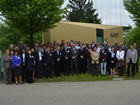|
Participants in the 5th WMRIF at the Empa site in Dübendorf
Researchers from all over the world gathered for the fifth WMRIF at Empa in Dübendorf. Over two days, they debated topics relating to the effects of materials on health and the environment. Top class speakers from many of the world’s large materials research institutions and universities – such as NIST (USA), NIMS (Japan), KIT and the Fraunhofer-Society (Germany) and, of course, Empa – gave an insight into their research and development results.
Nanotechnology a major theme
Materials research in general is facing significant challenges, as Gian-Luca Bona, CEO of Empa, highlighted: “Climate change, energy security and health and the ageing society are the major problems of our time. It is in relation to the latter that issues on the theme of “Materials meet Life” are of the utmost significance.” Nanotechnology is the subject of particularly controversial debate in this context and continues to raise many questions especially with regard to synthetic nanotubes, whose effects on the human organism have not yet been thoroughly investigated. Here, the research being carried out at NIST and Empa is particularly called for; the two organisations are working together closely in this field in order to identify potential opportunities as well as risks and to evaluate them correctly.
Platform for the future
Empa is also at the forefront of medical technology. “Smart textiles” and “tissue engineering” offer almost infinite application possibilities, from textile sensors for monitoring the body, the early detection and monitoring of cancer, to cell regeneration and new types of hip implants made of ceramic. Several research institutes were able to present their research findings in this area at the WMRIF. This international exchange promotes and demands global cooperation. For Harald Krug, organiser of the event and member of the Board of Directors at Empa, the forum was a success. “As one of the leading materials research institutes, Empa is proud to host the fifth WMRIF and to offer a platform for new innovations and international collaborations.” When and where the next WMRIF will take place has yet to be decided. However, one thing is certain: Empa will again be there.
|

